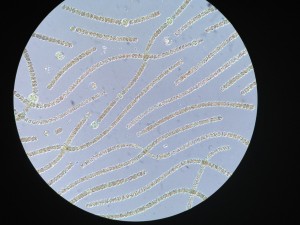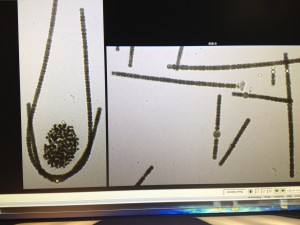Algae Blooms, Clackamas Cove, and CRW’s Monitoring Program
This week the Oregon Health Authority issued a health advisory after finding high levels of blue-green algae in the Clackamas Cove portion of the Clackamas River, located at Clackamette Park in Oregon City. Not to worry CRW Community! This algae bloom is about 4 miles past our drinking water intakes. This bloom will not affect your drinking water!
So what is this algae bloom anyway?
Algae are free-floating organisms that make up the base of the food chain in aquatic environments. That means that they are vital component of the ecosystem, including the Clackamas River. Their size ranges from tiny microscopic cells floating in the water column (phytoplankton) to large mats of visible “macroalgae” that grow on bottom sediments or rocks. Algae aren’t necessarily plants, but they behave a lot like them, soaking up the sunlight to produce energy while converting carbon dioxide to oxygen during photosynthesis. So algae are actually really good for the Clackamas River!
However, just like cake, too much of a good thing can cause it to become not so good. When algae populations explode to unusually high numbers they create what are called harmful algae blooms (HABs). HABs are primarily fueled by excess nutrients (nitrogen and phosphorous) in area waterways, which come from agriculture, air deposition, septic systems and sewage treatment plants, and runoff from lawns, gardens and paved surfaces.
Some algae that make up HABs have the potential to produce harmful chemicals that are toxic to humans, wildlife and aquatic life. Unfortunately, this is the dominant type of algae in the Clackamas Cove bloom.
What’s CRW doing about HABs?
HABs in our region are difficult to predict and control. What causes a HAB to form (or not) can be the result of many things and the tiniest changes in environment. At CRW we’re hoping to be able to predict the onset of an algae bloom one day, but it all starts with monitoring and collected data. CRW monitors algae populations and nutrients (nitrogen and phosphorous) at a number of sites in the Clackamas River Watershed including CRW’s intake. The instruments CRW uses for algae monitoring allow for the rapid identification and quantification of algae and nutrients in the system. Over the next year this program will be expanding in collaboration with Clackamas Community College to include toxin identification.
So who’s the trouble maker in Clackamas Cove?
Right now it looks like a little trouble maker called Anabaena. Anabaena is a genus of cyanobacteria (also known as blue green algae) that exists as plankton (those tiny microscopic cells floating in the water column we mentioned above). It is known for its ability to fix nitrogen. That means that they can potentially outcompete other organisms under certain conditions.
They are one type of cyanobacteria that can potentially produce toxins, which are harmful to local wildlife, farm animals, pets, and even humans is consumed in enough quantities. The toxin has been known to give some people rashes after swimming in the water. While Anabaena blooms don’t always produce toxins it’s always best to use caution. Keep kids and pets away from the water when a HAB is occurring.









